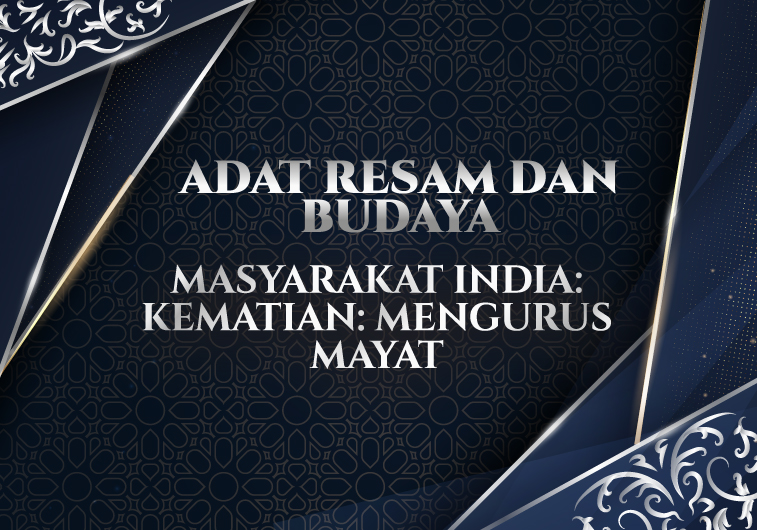ARTS AND CULTURE INFORMATION GATEWAY
Immerse yourself in the colorful world of art and culture! From traditional heritage to contemporary works, discover uniqueness that reflects the nation's identity and identity
ADAT RESAM DAN BUDAYA MASYARAKAT INDIA: KEMATIAN: MENGURUS MAYAT
Picture
1
Video
No record
Today's Visitor
368
Number of Visitors
1415
Introduction and history
Indian society believes in the concept of rebirth, where death is treated as sleep, and the soul will "wake up" afterwards. According to Indian scholars, death is the separation between spirit and body. The body will be destroyed, but the spirit will return to the barzakh realm. In practice, the bodies of Indian people are either cremated or buried.
Here are some of the main functions and roles:
Completing the Death Ceremony Based on Hinduism
The process of managing the body according to Hindu beliefs aims to ensure that the spirit of the deceased can move to the next world peacefully through religious rituals that are followed, such as cremation and the kollic catti ceremony.
Asking for Peace for the Spirit of the Dead
This custom aims to ensure that the spirit of the deceased finds peace and protection during the transition to another world. It involves various rituals, such as burning incense, praying, and using sacred fire.
Maintaining Cleanliness and Purity
The process of taking care of the corpse involves cleaning the corpse with turmeric, camphor, and holy water. This is important to keep the corpse physically clean and symbolically cleanse the spirit for the final journey.
Honoring the Dead and Fulfilling Family Responsibilities
Family members are responsible for ensuring that the death ceremony is carried out perfectly as a final sign of respect for the deceased. Rituals such as inserting a coin into the dhoti symbolize permission to cremate the body and release the spirit.
Reducing Family Grief
Ceremonial processes, such as surrounding the corpse and burning firewood, have a therapeutic role for the family. It helps them overcome grief by giving spiritual meaning to parting with the deceased.
Preserving Traditions and Cultural Heritage
Managing the corpse according to custom is a way to preserve the Indian cultural heritage in Malaysia. It ensures that traditional values and religious practices are passed on from generation to generation.
Showing Family and Community Unity
This process involves family and community members participating in various aspects of corpse management, showing moral and emotional support, and strengthening community bonds.
Kollic Catti
Kollic catti refers to a clay pot filled with fire. This pot is lifted using a coconut frond tied at the end and carried by a family member of the deceased, either son or father. The person carrying this pot has to accompany the corpse while sacred songs are played all the way to the cremation ground.
Managing the Corpse
The corpse will be placed in the living room with the head facing south. An oil lamp (kaamaatci amman vilakku) is lit, a coconut is split in half, and sirih pinang is placed near the corpse. Incense and camphor are burned as a symbol of peace of mind. Holy powder (tiruniiru) is rubbed on the forehead before the prayer ceremony. The corpse is carefully guarded; thumbs and toes are tied with white cloth, hands are placed on the chest, eyes are closed tightly and turmeric is applied before being wrapped in cloth to disinfect. Crushed sirih pinang is put into the mouth, and the nose is stuffed with cotton, while a coin is placed on the forehead. Rose water is sprinkled on the corpse and the corpse is fumigated with incense to remove the smell. As a sign of the family's grief, the pictures in the house are turned upside down and the jewellery is taken out of the living room.
Vaaikkaris Ceremony
After the body is bathed and decorated, it is placed in a coffin with camphor to prevent the smell. A little rice is also put in the mouth of the deceased as a symbol of the last gift, known as vaaikkarisi. The body is then placed in the living room.
Cremation
The coffin is then taken to the cremation ground using a stretcher. Once there, the stretcher bearer pays the crematorium maintainer. The coffin is moved several times towards the burning place, starting with the legs and then the head, which is believed to symbolize the deceased entering the belly of the Earth Goddess. Firewood is arranged in the crematorium. The corpse is placed on it and covered with a layer of firewood and dried cow dung, which is then sprinkled with burning oil. A coin is inserted into the dhoti as a sign of permission to cremate the body. The prayer ceremony begins, and the kollic catti bearers circle the corpse three times clockwise. In the third round, they kneel before the corpse without facing it. Three sticks of fire are stuck to the ground one by one, with the aim of reducing the grief of the family of the deceased.
Reference Source
Bahan Bacaan:
AnyFlip (2021). Kepelbagaian Adat Resam Dan Budaya Masyarakat Malaysia. https://anyflip.com/nqyhr/zzmg/bas
Hema. (2017). Adat Resam Dan Budaya Masyarakat Malaysia. https://adatresammasyarakatmalaysia.wordpress.com/2017/02/21/first-blog-post/
(3) Zuraiha Binti Mohd Zain Noraini Binti Sulaiman Siti Aishah Binti Othman. (2021). Adat Resam Masyarakat Malaysia. Politeknik Tuanku Sultanah Bahiyah.
https://upk.ptsb.edu.my/penerbitan/Adat_Resam_Masyarakat_Malaysia.pdf
Tokoh (jika ada temu bual tokoh) - Tiada -
Location
State JKKN Contact Information
Ahmad Zaimy bin Mohd Yusoff
Cultural Officer
Jabatan Kebudayaan dan Kesenian Negara, Selangor
Tingkat 6, Menara Korporat,
Kompleks IDCC Shah Alam
Jalan Pahat L 15/L, Seksyen 15
40200 Shah Alam,
SELANGOR DARUL EHSAN
03-5543 1654 /1763







